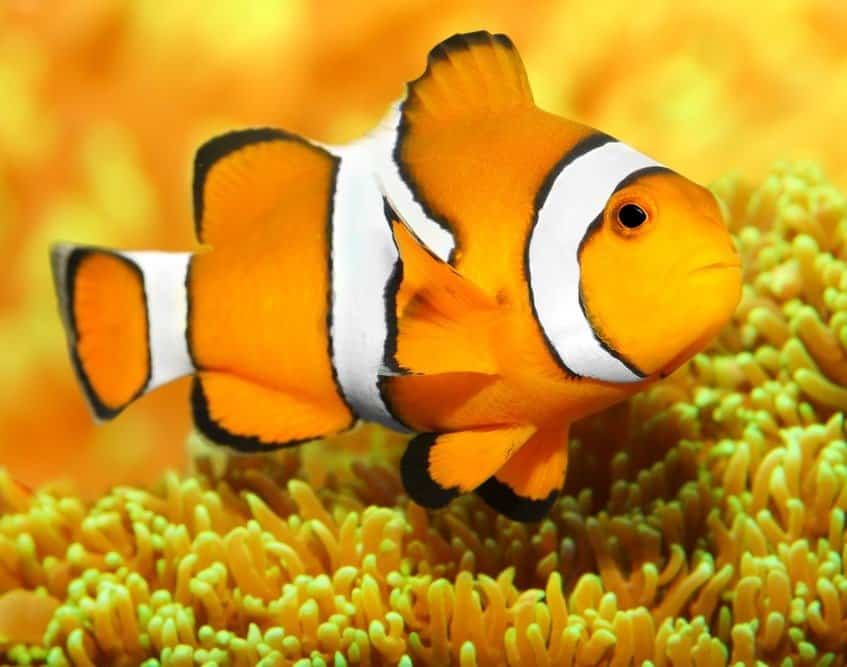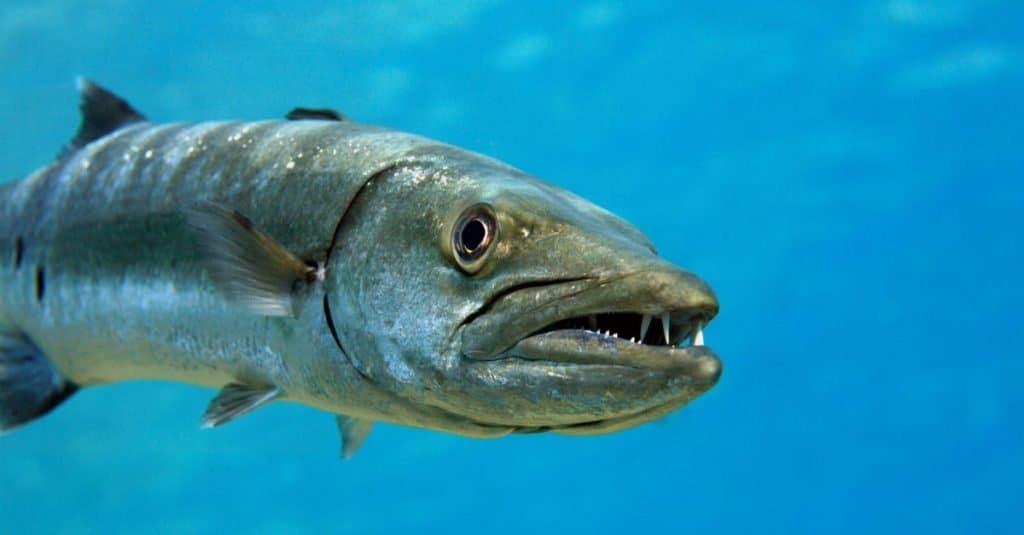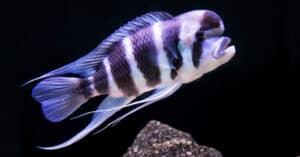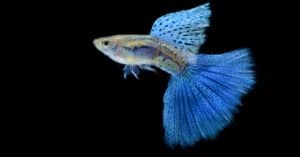Clownfish are prominent fish that stand out because of their bright orangish or reddish coloring and distinctive look. Most recently, people have become more knowledgeable about this species because of it featuring in the film “Finding Nemo.” Yet, there is more to this delightful fish than starring in animated films, starting with their symbiotic relationship with sea anemones, giving rise to their moniker anemonefish. So, what do clownfish eat? How do they find food and stay out of harm’s way?
We’re going to consider all these elements and show you why the clownfish is such an interesting sea creature.
What Foods Do Clownfish Eat?

Clownfish are omnivores that eat plankton, algae, and shrimp.
©Tatiana Gordievskaia/Shutterstock.com
Clownfish eat zooplankton, phytoplankton, algae, and a variety of other foods. They are omnivores that feed on a diverse selection of foods in the ocean. Part of their diet is based on what foods they capture on their own, but some other sources come from their symbiotic relationship with sea anemones. Consider the main foods that clownfish eat:
- Mysis shrimp
- Brine shrimp
- Zooplankton
- Phytoplankton
- Algae
- Krill
- Smelt
- Black worms
- Copepods
- White worms (Enchytraeus albidus)
- Various leftover foods from the sea anemone.
These are the more common foods that clownfish eat, and an interesting thing to note is that clownfish do not source all their meals in the wild. Instead, they form a symbiotic bond with sea anemones where the clownfish lives inside the flowery-looking predator’s tentacles. The fish generates mucus that protects it from the tentacles deadly sting, but other creatures are not so lucky.
When the sea anemone is finished eating something it has killed and captured, the clownfish will often eat what’s left. The clownfish also benefits the sea anemone by leaving some fecal matter for their hosts to consume, providing beneficial nutrients. This interesting living situation ensures the clownfish can find and consume food in relative peace.
What Do Clownfish Eat in Captivity?

Clownfish mostly eat shrimp, worms, and prepared fish flakes in captivity.
©Kletr/Shutterstock.com
Clownfish are a very popular tropical fish for people to keep as pets. As a result of their appearance in the aforementioned film series, these fish have become a hot commodity. In fact, they have been over-harvested from their natural habitats and now represent more than 40% of the ornamental fish trade around the world, along with other members of the Pomacanthidae family.
The systematic removal of clownfish from their natural habitats has led to some areas of the world losing almost their entire population of anemonefish. They instead live in private aquariums where they rarely have a chance to breed while their natural habitat loses the benefit of their presence, especially the sea anemone.
When they are placed in aquariums, clownfish lose access to many of the foods that they commonly eat in the ocean, and they are often away from the sea anemone that leaves food for them.
In captivity, clownfish will commonly eat:
These are the most common foods available for clownfish when they are being kept in an aquarium or as a pet. These fish tend to be very territorial when they are introduced to a new setting, mostly as a result of their instincts to live in a sea anemone and rarely venture out of the habitat.
How Do Clownfish Find Food in the Wild?

Clownfish will wait for the sea anemone to kill prey and then feed on the leftovers.
©Tareq.n.o/Shutterstock.com
Clownfish find their food in the wild using several methods depending on what they’re trying to eat. As we have said before, the fish have a symbiotic relationship with sea anemones. Oftentimes, they will sit amongst the tentacles of the host and wait for something tasty to float by.
Sometimes, a small shrimp will float by that they can eat on their own, and other times they will wait for the sea anemone to kill one of its prey and then eat the leftovers that remain.
Clownfish rarely venture forth from the sea anemone because they immediately lose all their defenses by doing so. However, they will sometimes depart to forage on the surface of a nearby reef where they will look for plankton and algae.
Other times, they will spot one of their chosen foods floating in the water column, leave their safe space temporarily, and pick the food out of the water. They’re not tremendous hunters, merely very opportunistic creatures that benefit from having sea anemones to keep away predators.
What Predators Eat Clownfish?

Barracudas have the speed to catch clownfish.
©aquapix/Shutterstock.com
Clownfish have very few ways of protecting themselves since they are neither fast swimmers nor capable of fending off other predators. In fact, their best means of protection come from the sea anemone. Although some predators will learn a painful or deadly lesson charging into the sea anemone in pursuit of a clownfish, sometimes they can successfully catch an anemonefish through patience alone.
As we’ve mentioned, clownfish will sometimes leave the safety of their living area to graze on the reef. That is when predators will strike, swooping in for a quick meal or netting them so they can be sold to others.
These are the most frequent predators of clownfish:
The barracudas are fast swimmers and have long snouts that can snatch up clownfish with ease, but it’s the humans that clownfish need to worry about. Millions of these fish have been plucked out of their native waters to decorate aquariums and live out their lives as pets. They require careful housing and the presence of an anemone in their tank if they’re survive for a long time.
Unfortunately, humans are also harming the reefs clownfish live in and have been cutting down on the native populations, reducing the number of anemonefish in the ocean. The overall impact on the species is unknowable right now, but no creature poses so much danger to clownfish as humans.
Clownfish are famous yet shy omnivores that feed on shrimp, other fish, and various planktons. Their symbiotic relationship with sea anemones is remarkable and helps keep them safe and well-fed. Although these fish are beautiful, their physical characteristics and presence in films have made them a target for humans to collect, and the species may be headed down a dire path as a result.
Summary of 10+ Foods Clownfish Consume
Here’re a recap of the main foods that clownfish will eat in the wild:
| Number | Food |
|---|---|
| 1 | Mysis shrimp |
| 2 | Brine shrimp |
| 3 | Zooplankton |
| 4 | Phytoplankton |
| 5 | Algae |
| 6 | Krill |
| 7 | Smelt |
| 8 | Black worms |
| 9 | Copepods |
| 10 | White worms (Enchytraeus albidus) |
| 11 | Various leftover foods from the sea anemone |
And here’s a summary of what to feed clownfish kept as pets:
| Number | Food |
|---|---|
| 1 | Mysis |
| 2 | Krill |
| 3 | Smelt |
| 4 | Brine |
| 5 | Frozen worms |
| 6 | Squid pieces |
| 7 | Mussels in small amounts |
| 8 | Prepared fish food |
| 9 | Spinach |
| 10 | Nori |
The photo featured at the top of this post is © Oksana Golubeva/Shutterstock.com
Thank you for reading! Have some feedback for us? Contact the AZ Animals editorial team.






